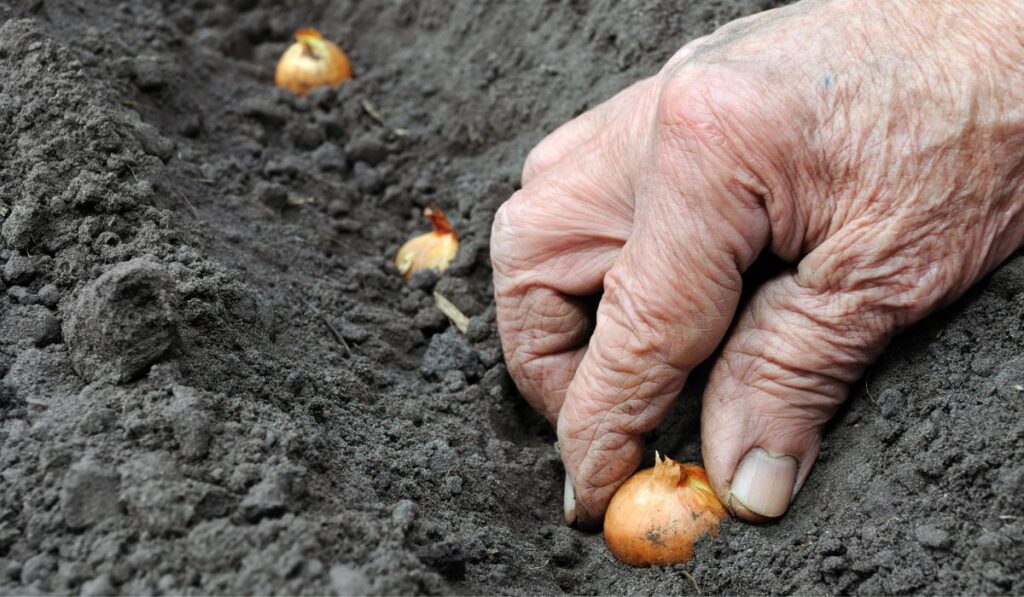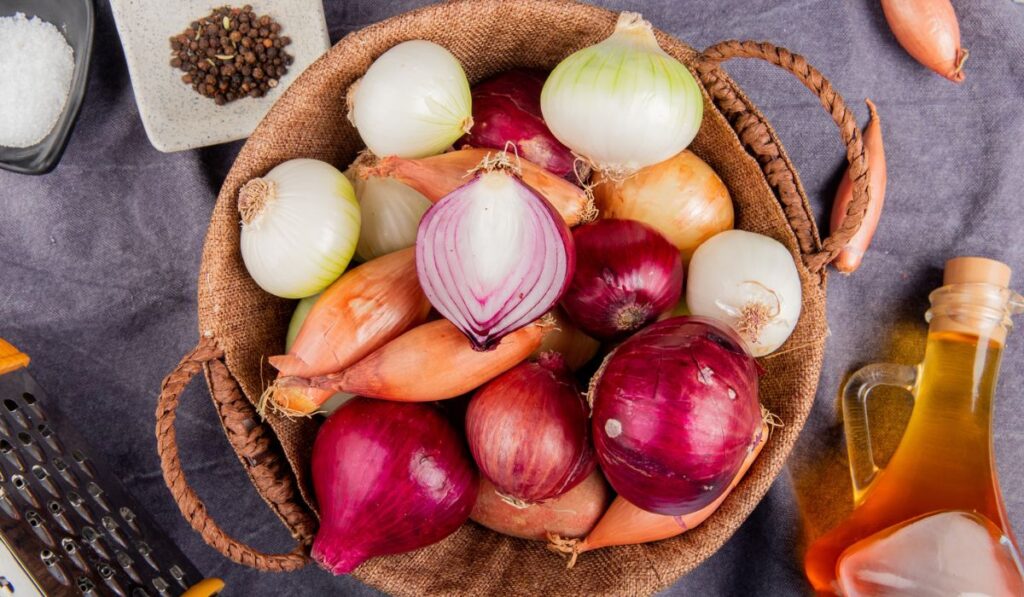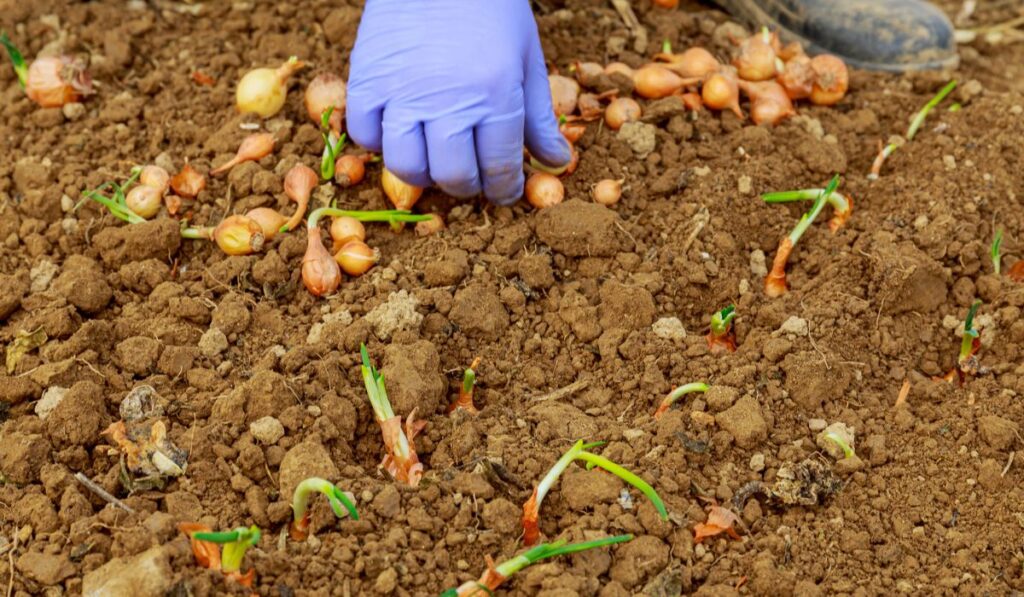Onions are one of the most popular plants to grow in vegetable gardens and a staple worldwide. But are they difficult to grow? And how should you grow different types of onions in your garden?
Most onions require cooler weather to grow and should be planted in early spring. Long-day types grow best in full sun with at least 12 hours of daylight, while short-day types can be grown in semi-shaded areas. Onions require nutrient-rich and well-drained soil to flourish.
Let’s explore how to grow onions based on each of the main onion types. We’ll discuss how the types differ in appearance and flavor, when it’s best to plant them, and how to water and maintain them.
What Time Of Year is Best for Planting Onions?

The best time of the year to plant onions is in early spring if you live in an area with cold winters. If you live in a warmer region (USDA zones 7-10), you can plant the onion bulbs in late fall or even winter. Onion bulbs grow best in warm weather, but the shoots come out when the weather is slightly cooler.
It’s always best to plant onions as the cool season is nearing its end, just before the start of spring or in early spring. The weather should be cool but not freezing, or the onions won’t grow properly. Onion bulbs will develop in the summer, and you can usually harvest them in late summer or early fall.
Most expert gardeners recommend planting onions from small bulbs (on Amazon). You can get these at any nursery that grows vegetables. You can plant onions from seeds (also on Amazon), but they take four to six weeks to develop bulbs.
When planting onions from seeds, try planting them indoors in a slightly warmer environment, so the seeds germinate faster. If your goal is to get a summer or fall harvest, plant the seeds four to five weeks before spring starts. You can then transfer the young bulbs to your garden when the weather starts warming up in early spring.
There’s no harm in planting onions in late spring, but they may have stunted growth as these plants prefer cooler weather. If you live in Florida or parts of California where the winters are very mild, your onions may grow best in the middle of winter.
What Are the Different Types of Onions?

While there are hundreds of different onion varieties, these are often classified into six or seven distinct types. These may vary in shape, taste, size, and propagation methods.
Some onion varieties are much sweeter, while others are stronger and taste more like garlic. Even garlic is botanically classified as onions!
Some common onion types include:
White Onions
While they aren’t classified as “sweet,” white onions are sweeter than many other onion varieties. They have white, papery skin and have higher sugar content than yellow onions.
White onions are usually used in fresh salads and salsas, but they have a lower shelf life and are less economical to grow. Nevertheless, they are ideal for growing in your garden!
Yellow Onions
Yellow onions are the most commonly used for cooking and have a strong, burning flavor. These onions are used in soups and stews and can retain their flavor for much longer than other varieties. Yellow onions get their name from their thick, brown skin and are by far the most commonly used onion type.
Sweet Onions
Sweet onions have high sugar content and are much sweeter than many other onion varieties. They resemble white onions but are much bigger and require wetter soil for optimal growth. These onions are ideal for caramelizing and making onion rings.
Red Onions
Red onions are a favorite for many people due to their bright red or light purple color and sweet taste. They can easily be eaten raw and rarely have a storing taste. These onions are also easy to grow and are perfect for salads, salsas, and other dishes that require fresh onions.
Green Onions
Also known as baby onions, green onions are immature onions that are used for salsas, fresh salads, and a variety of other dishes. While they aren’t technically a “type” of onion, they are sold as such, and many people view them differently.
While you can use any onion type to grow green onions, they are best grown from sweeter onion varieties as the green shoots are much tastier.
Other popular onion types include chives, scallions, pearl onion, and shallots. These are usually used for very specific dishes, and some are slightly more difficult to grow than more regularly used varieties.
Which Climate is Best for Growing Onions?
A temperate climate is best for growing onions since the weather variations are more gradual, and there’s a better balance between hot and cold weather. However, onions are hardy plants and can grow in any climate if you adjust their growing conditions properly.
Your onion yield will depend on temperature variations, planting time, and other cultivation factors. Onions grow best in climates where early spring is cool but not cold enough to kill the plant. However, they don’t grow well in regions with extreme heat or humidity, as this will prevent shoots from growing properly.
However, onions are grown worldwide, and there’s no reason why you can’t grow them in your local climate. Let’s look at growing techniques for cultivating onions in different climates:
Temperate Climate
If you live in an area where winter is cold, but the ground doesn’t freeze for long, and summers are hot but not miserable, then you can grow onions without much effort. Plant the onions in early spring and harvest them in late summer or early fall (depending on the variety).
Cold Climate
If you live further north, where the ground doesn’t thaw until late spring, you’ll have a shorter growing season, and it’s best to plant fast-growing varieties. Plant the onion bulbs in late spring as soon as the ground thaws and strive for an early fall harvest.
Tropical Climate
While onions grow in full sunlight, they aren’t suited to hot and humid climates. The extra moisture in the soil will cause the onions to rot. If the weather is too hot when you plant the onions, the leaves won’t grow properly, and you’ll end up with much smaller bulbs.
To grow onions in a tropical climate, you’ll have to plant them in winter when the weather is slightly less humid. Also, make sure the soil drains well, especially during the rainy months.
Dry Climate
While it’s not ideal, you can successfully grow onions in a dry climate, provided you water them properly. Onion bulbs need enough moisture to grow larger before they split, and dry soil will make them split prematurely, resulting in smaller yields.
Onion plants only need to be watered once or twice a week, but you may have to water them every second day in a drier climate. Try watering them at night or before sunrise to minimize water evaporation from the soil.
How to Prepare Your Soil for Planting Onions
Onions need well-drained, moist soil to grow properly. They grow in slightly acidic and neutral soils with a pH of 6-6.8. Since onions naturally grow well in moderate climates, it’s best to grow them in soil that holds enough moisture but isn’t clay.
If you’re planting onions from seeds, it’s best to plant them in a nursery area or pot until a small bulb develops. If you’re planting onion bulbs, you can plant them directly in the soil. Follow these steps to prepare the soil for growing onions:
- Loosen the soil with any suitable gardening tool. If you have soil that doesn’t drain well, create a raised soil bed.
- Add nitrogen fertilizer (on Amazon) to the soil before planting the onion bulbs. Onion plants require proper nutrients for optimal growth.
- Bury the onion sets 1 inch deep in the soil. Make sure the pointed end is facing up.
- Onions should be planted at least 5 inches apart, especially if you’re growing larger varieties.
Once you’ve prepared the soil properly, you’ll have to maintain it by watering it regularly. You have to add fertilizer to the soil once before planting, and more as the bulbs start growing.
How to Plant Onions

Onions aren’t a true root crop because they require strong leaves for proper bulb growth. While they are a cool weather crop, they need full sunlight, especially during the first growth phase. Onions require fertilized soil that’s well drained but doesn’t need as much water as other vegetables.
While these factors are common for all types of onions, different types are more suitable for certain growing conditions. Let’s look at each onion type and how to grow them:
Short-Day Onions
Short-day onions grow in slightly cooler climates and don’t require as much sunlight as full-day varieties. These onions will grow best when there are around 10 hours of daylight, and the temperature is moderate.
Always plant short-day onion types earlier in the spring and add more water and fertilizer to the soil during the initial growth phase. Once the leaves have developed properly in the spring, there’s more chance that you’ll get bigger onion bulbs for a late summer harvest.
Long-Day Onion Types
When growing long-day onions, you don’t have to worry about planting them later in the spring. These onion varieties often need less watering (once a week is enough) and will grow in slightly hotter weather.
Never plant long-day onion types in a shady area, as they may not develop properly. If you only want green onion leaves, you can plant them in the shade.
Day-Neutral Onion Types
These onions are ideal since they can grow in any climate and will thrive in slightly shady or full-sun areas. However, it’s best to plant these onions when there are at least 10 hours of sunlight, and the weather isn’t freezing.
More Onion Growing Tips
- Onions require nutrient-dense soil, so make sure to add fertilizer every three weeks for a bigger harvest.
- Water onion plants once a week or twice if you live in a dry area.
- When the tops turn yellow, it means the onions are starting to mature. Don’t harvest them just yet.
- When the tops dry completely and turn brown, it means your onions are ripe and ready for harvest.
